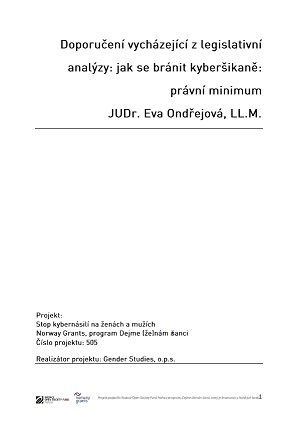
We kindly inform you that, as long as the subject affiliation of our 300.000+ articles is in progress, you might get unsufficient or no results on your third level or second level search. In this case, please broaden your search criteria.

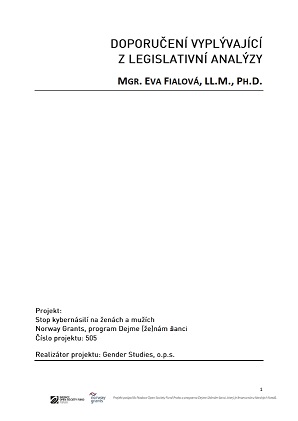

This issue of Robotrolling examines users suspended by Twitter. Contrary to expectation, most of the accounts were human-controlled accounts rather than bots. Since 2017, the speed at which Twitter suspended misbehaving users has by two measures almost doubled. However, removals of Russian-language accounts have been considerably slower than for English. The speed of removal can be critical, for instance in the context of an election. The Latvian elections, conducted on 6 October 2018, passed with remarkably little Russian language activity about the NATO presence in the country. Our analyses show a movement in the past year away from automated manipulation to humans operating fake or disposable identities online. The figures published in this issue reflect the good work done to tackle bots, but show much work remains to tackle manipulation through fake human-controlled accounts. Bots created 46% of Russian-language messaging about the NATO presence in the Baltics and Poland. More than 50% of Russian-language messaging about Estonia this quarter came from automated accounts. Anonymous human-operated accounts posted 46% of all English-language messages about Poland, compared to 29% for the Baltic States. This discrepancy is both anomalous and persistent. Some of the messaging is probably artificial. We continue to publish measures of fake social activity in the hope that quantifying the problem will focus minds on solving it.
More...
On the popular Russian-language social network VK, material about the NATO presence in the Baltics and Poland was viewed no less than 11 million times this quarter (February – April 2019). 93% of these views were for material from community spaces. On VK, community spaces are increasingly important, both as a sources of content and as places for discussion. The move to groups has implications beyond the Russian-language space. Facebook has recently launched a push to promote community spaces. These spaces, normally closed to researchers, offer huge potential for misuse and manipulation. Our investigation of VK community spaces reveals that the vast majority of groups in which NATO is discussed are communities with radical pro-Kremlin or nationalist tendencies, or dedicated to the conflict in Ukraine. These communities generate more posts and attract more views even than communities created by Russian state media outlets. On Twitter, bots tweeting in Russian remain a bigger problem than bots tweeting in English. In Russian, they account for 43% of all messages—a significant increase in recent months. In English bots posted 17% of messages. English-language bots this quarter overwhelmingly amplified news content from RT (formerly Russia Today) and other pro-Kremlin news outlets. On all platforms, discussion regarding NATO troops in Poland attracted the largest number of posts this quarter. Finally, in this issue we publish our first case study of manipulation on Facebook. It looks at the degree to which bots and trolls targeted posts promoted by Latvian political parties contesting the European Elections in late May 2019.
More...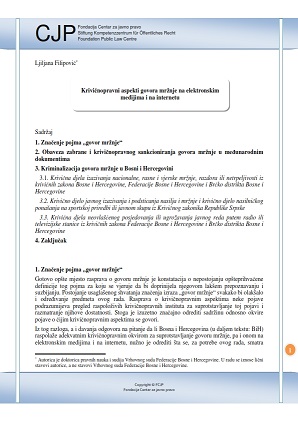
The paper considers some criminal law aspects of “hate speech” on electronic media and internet. After the definition of meaning of the term “hate speech” provided for the needs of the paper, and a review of obligations of the member States concerning prohibition and criminalization of hate speech in certain international legal documents, the paper also gives a review of the manner and scope of criminalization of hate speech in the criminal codes in force in BiH. In addition to an analysis of the principal legal elements of the related criminal offenses, the paper pays a special attention to the preconditions which must be satisfied in order that a conviction for the criminal offense of hate speech is not in violation of the right to free expression as one of the fundamental human rights. The paper also refers to the responsibility of journalists and media for hate speech and its spreading, as well as the responsibility of mediators – service providers for hate speech of others.
More...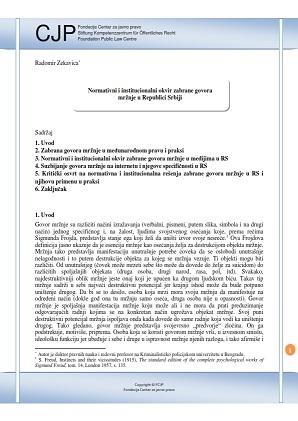
After analyzing the prohibition of hate speech in international law and practice, the author analyzes the normative and institutional framework for hate speech prohibition in Serbia. The analysis points to valid legal solutions to this prohibition, regulations of regulatory bodies that are responsible for combating hate speech in print and electronic media and the Internet, and then provides an overview of institutional mechanisms of protection against hate speech. After that, the author gives a critical overview of the functioning of the normative-institutional framework for the prohibition of hate speech and points to the key problems, first of all: the problem of media freedom, the high degree of non-recognition of the essence of discrimination and hate speech among representatives of the public authorities, the problem regarding the functioning and independence of regulatory bodies, but also the judicial system in general. Political discourse in Serbia is burdened with the spirit of intolerance and rhetoric that often contains hate speech. The fact that pro-government media often appear as actors of such rhetoric is worrying, as it points to the readiness of the public authorities to promote a critical dialogue that is the premise of a healthy democratic society.
More...
If the seriousness of a given “emerging security threat” is measured by the number of recent analyses devoted to it or the proliferation of experts studying it, then cyberthreats must now surpass the dangers of offline terrorism and energy security. While all issues “cyber” attract a high level of policymaker attention, another threat seems to have been forgotten and marginalised: cyberterrorism. To an extent, the evolution of cyberterrorism mirrors that of “regular” terrorism, which erupted as the “weapon of the weak,” and after a state-sponsored phase seems to be returning to its sub-state or even “lone wolf” roots. Cyberthreats, on the other hand, originally of a sub-state nature, are now mostly in the domain of state entities that have not yet made the decision to launch state-sponsored cyberterrorism.
More...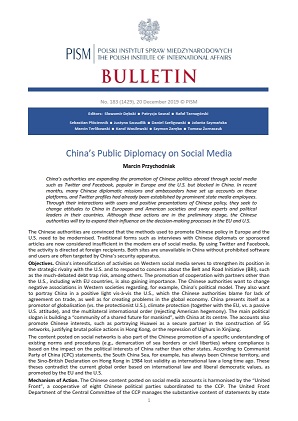
China’s authorities are expanding the promotion of Chinese politics abroad through social media such as Twitter and Facebook, popular in Europe and the U.S. but blocked in China. In recent months, many Chinese diplomatic missions and ambassadors have set up accounts on these platforms, and Twitter profiles had already been established by prominent state media employees. Through their interactions with users and positive presentations of Chinese policy, they seek to change attitudes to China in European and American societies and sway experts and political leaders in their countries. Although these actions are in the preliminary stage, the Chinese authorities will try to expand their influence on the decision-making processes in the EU and U.S.
More...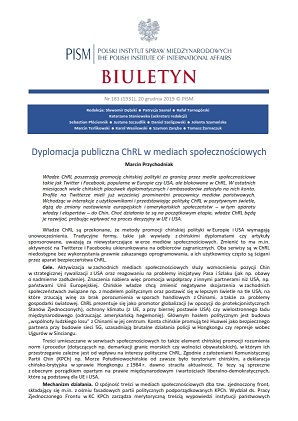
Władze ChRL poszerzają promocję chińskiej polityki za granicą przez media społecznościowe takie jak Twitter i Facebook, popularne w Europie czy USA, ale blokowane w ChRL. W ostatnich miesiącach wiele chińskich placówek dyplomatycznych i ambasadorów założyło na nich konta. Profile na Twitterze mieli już wcześniej prominentni pracownicy mediów państwowych. Wchodząc w interakcje z użytkownikami i przedstawiając politykę ChRL w pozytywnym świetle, dążą do zmiany nastawienia europejskich i amerykańskich społeczeństw – w tym aparatu władzy i ekspertów – do Chin. Choć działania te są na początkowym etapie, władze ChRL będą je rozwijać, próbując wpływać na proces decyzyjny w UE i USA.
More...
The Russian authorities actively use the digital space to achieve foreign policy goals. On Russia’s initiative, the UN General Assembly adopted two new resolutions in the field of cybersecurity. The first concerns the rules of conduct of states on the internet and the second deals with cybercrime. They were adopted despite opposition from Western countries. Russia is trying to protect the Russian network against external influence. The aim of these activities is ensuring the stability of the internal political regime.
More...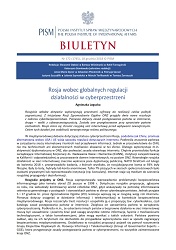
Rosyjskie władze aktywnie wykorzystują przestrzeń cyfrową do realizacji celów polityki zagranicznej. Z inicjatywy Rosji Zgromadzenie Ogólne ONZ przyjęło dwie nowe rezolucje z zakresu cyberbezpieczeństwa. Pierwsza dotyczy zasad postępowania państw w internecie, druga – walki z cyberprzestępczością. Zostały one przegłosowane przy sprzeciwie państw zachodnich. Rosja stara się chronić rosyjską sieć internetową przed wpływami zewnętrznymi. Celem tych działań jest stabilność wewnętrznego reżimu politycznego.
More...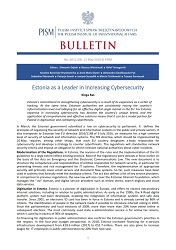
Estonia's commitment to strengthening cybersecurity is a result of its experience as a victim of hacking. At the same time, Estonian authorities are consistently raising the country's informatisation level and lobbying for an effective digital single market in the EU. For Estonia, expertise in increasing cybersecurity has become the country’s unique brand, and the application of comprehensive and effective solutions means that it can be a model partner for Poland in digitisation and combating cyberthreats.
More...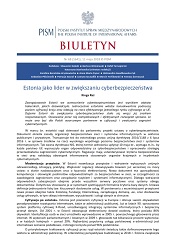
Zaangażowanie Estonii we wzmocnienie cyberbezpieczeństwa jest wynikiem ataków hakerskich, jakich doświadczyła. Jednocześnie estońskie władze konsekwentnie podnoszą poziom cyfryzacji kraju oraz lobbują na rzecz efektywnego jednolitego rynku cyfrowego w UE. Dążenie Estonii do zwiększania cyberbezpieczeństwa stało się wręcz jej znakiem rozpoznawczym. Stosowanie przez nią kompleksowych i efektywnych rozwiązań sprawia, że może ona być dla Polski wzorcowym partnerem w cyfryzacji i zwalczaniu zagrożeń cybernetycznych.
More...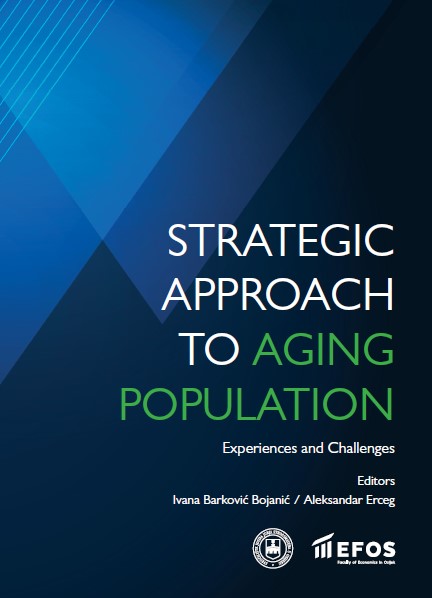
People across the world are living longer. According to the World Health Organization (2018), the world population that is older than 60 years will reach 22% by 2050, amounting to 2 billion people, which is a significant increase from 900 million in 2015. The number of older persons will outnumber children younger than five years. The pace of population aging is much faster than before, forcing all countries to face challenges that age brings, from health issues to human rights issues, each requiring proper policy response. As societies grow older due to increased longevity and improved health, older people change in terms of expectations they have related to life in the retirement age. There are many inspiring examples of older persons who want to pursue new activities, such as education, engage in a new career that corresponds to their passion neglected earlier, or continue to be a productive family or community member. It is not surprising to see that some older persons do not make a direct transition from employment to retirement but rather self-employment, implying a positively inverted U-shaped relationship between age and entrepreneurship. For example, to prove it, let us remember the founders of McDonald’s, Coca Cola and Kentucky Fried Chicken, were all over 50 years old when they established their business. One can conclude that older persons are heterogeneous, making aging difficult to handle research and policy-wise.
More...
The report outlines: the current situation in the Red Sea and the Somali Basin, examining its impact on international maritime transport. Discussed are key principles of international law and organizations involved in combating piracy and armed robbery, detailing incidents occurring from 2019 to 2023. The mission and tasks of Operation “Atalanta”, which is one of the primary anti-piracy operations in the Somali Basin, are described along with the current situation in the Area of Operation (AOO). The report briefly narrates the situation with M/V Ruen. It outlines conditions under which the use of Bulgarian Naval Forces in countering piracy is feasible. The paper proposes some directions for addressing piracy and armed robbery issues.
More...
The objective of this paper is to analyze the perception of university students towards fake news by assessing the relationship between the incidence of fake news shared by themselves within their social networks and the risk assumed by students when sharing news they do not fully trust. Quantitative study through the application of a survey using a Likert scale applied to 313 students from different careers of the Faculties of Administration and Pedagogy of the Universidad Veracruzana in Mexico. Processing was carried out with descriptive and inferential statistics. The results point out the correlation between the risk assumed and the cases of false news shared indicating the existence of cases in university students with little predisposition to inquire into the reliability of the information, and who in turn, risk sharing it anyway. The variables of sex, age, semester, and educational program do not influence the risk that students assume when sharing news. However, students who claim not to share news they distrust also share fake news they do believe in on their social networks.
More...
Following global trends, social media has become an instrumental part of daily life for most Albanians. Even before the COVID-19 pandemic, it was a primary means for social communication and receiving information on current affairs. Moreover, since the outbreak of the pandemic, social media has cemented its position as an irreplaceable aspect of people’s personal and professional lives. While it is wonderful that the internet allows education, business, and daily life to continue, there are some challenges to such dependency on social media. For example, disinformation spreads six times faster through social media channels than actual news, and social media platforms create opportunities for unsupervised communication, which can lead to harassment, abuse, and blackmail.
More...
This report examines the concept of „digital narrative“, with a focus on clarifying the nature and application of digital narrative in election campaigns, with the aim of collecting and systematizing my currently available scientific information in the indicated direction. The concept of 125 „digital narrative“ is central to my dissertation research and the information referenced here will be used in it. In clarifying the essence of the digital narrative, the following methodological framework was used: who is the subject of the digital narrative, i.e. who is the digital storyteller, what is the digital story in terms of classical communication models, what are the possible applications of the digital story. This methodological framework predetermines the structure of the present exposition. The application of digital storytelling in campaign communications is explored in a one-day special.
More...
The article raises the question of the „fate“ of man and society in the conditions of the turbulent global transformations of the entire existence of human civilization in the first decades of the XXI century, and in particular – of security and the advance of AI, emphasizing the possible, but already actual, negative consequences/threats of artificial intelligence, in the conditions of which humanity has been living for a long time.
More...
This report presents a literary study of the safety of children in the perspective of time from the first to the third wave of social development in the Alvin Tofler. Nowadays, it is the safety of children that is one of the most frequent discussion topics, which brings together conscious scientific, political, civic, parental thoughts and actions. The main research question is: whether and in what direction the need for safety of children is changing in historically different societies? To achieve this goal, the conceptual framework of the research is introduced – child, childhood, security, digital inequality. Then a summary historical projection of the development of children‘s security in different societies is presented to reach the third part, whose emphasis is on aspects of children‘s safety today, in the information, networked, digitally layered society of the Fourth Industrial Revolution.
More...